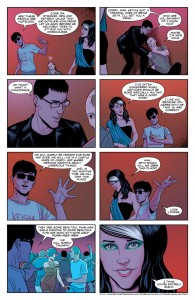Phonogram: The Immaterial Girl 1
Reviewed by Tony Keen 24-Aug-15
Phonogram continues to be the best comic about pop music that you’re ever likely to read.
 Phonogram fans have waited a long time for the third volume of Kieron Gillen and Jamie McKelvie’s pop magicians story. Singles Club finished five years ago. The third volume was promised once, but put aside in favour of The Wicked + The Divine. Then recently it was announced that McKelvie was taking six months off WicDiv in order to draw The Immaterial Girl (Gillen just keeps writing scripts at his usual high levels of productivity).
Phonogram fans have waited a long time for the third volume of Kieron Gillen and Jamie McKelvie’s pop magicians story. Singles Club finished five years ago. The third volume was promised once, but put aside in favour of The Wicked + The Divine. Then recently it was announced that McKelvie was taking six months off WicDiv in order to draw The Immaterial Girl (Gillen just keeps writing scripts at his usual high levels of productivity).
All this, of course, means that the comic carries a heavy weight of expectation on its shoulders. It’s a bit unfair to judge it on only one issue, but so far it’s looking okay. Many of the regular characters, David Kohl, Emily Aster, Seth Bingo, Indie Dave, are back. (We haven’t seen Kid-with-Knife yet, but he’s been referred to.)
McKelvie’s art is, of course, gorgeous. He excellently renders various characters at different stages in their lives. He also continues to build everything around straightforward six or eight-panel grids, which makes the book easy to read.
The story picks up a thread that was dangled in Singles Club, about Emily Aster and how she reinvented herself. It’s more substantial and traditional a story than in Singles Club (which is not a criticism of Singles Club – one of the great things about that was that it was a comics story in which nothing much actually happened, but which seemed neither dull not trivial). As I say, it’s early days yet, but The Immaterial Girl remains true to the basic theme of Phonograpm, which is that it’s about the power to be found in pop music – except that this time it’s about the power to be found in pop music videos. You will never think of A-ha’s “Take On Me” in quite the same way again. Gillen also brings the story to London, something he has avoided a bit in the previous two volumes.
 As with The Singles Club, individual issues include “B-Sides”, short tales of Phonogram characters illustrated by guest artists, which will not be in the collected edition. There are two here, of which my favourite is the one drawn by letterer Clayton Cowles, in which we meet David Kohl of 2015 (the main story is set in 2009, with preludes in 2001 and the 1980s).
As with The Singles Club, individual issues include “B-Sides”, short tales of Phonogram characters illustrated by guest artists, which will not be in the collected edition. There are two here, of which my favourite is the one drawn by letterer Clayton Cowles, in which we meet David Kohl of 2015 (the main story is set in 2009, with preludes in 2001 and the 1980s).
Hopefully, The Immaterial Girl will at least persuade people who have discovered Gillen and McKelvie’s work through Young Avengers and WicDiv to check out the earlier volumes of Phonogram. And don’t be put off the first volume, Rue Britannia, by Gillen’s slight disparaging of it in the text page here – yes, it seems a bit primitive now, but really only in comparison with what Gillen and McKelvie have done since.
Phonogram continues to be what it always has been – the best comic about pop music that you’re ever likely to read.
Tags: Clayton Cowles, Image Comics, Jamie McKelvie, Kieron Gillen, Matthew Wilson, Phonogram, The Immaterial Girll